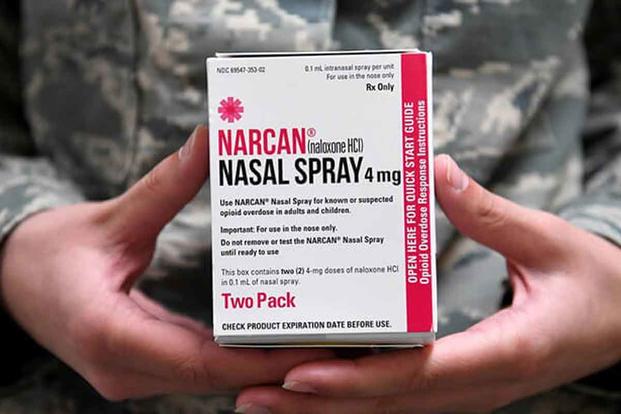A new law will require the Pentagon to start compiling data in 2024 on overdoses within the ranks, and to make available to troops an antidote for opioid overdoses, as the U.S. continues to battle increasing casualties from the fentanyl crisis.
Previously, overdoses within the military -- fatal and non-fatal -- weren't systematically tracked. The Defense Department will now have to maintain information such as what substances were involved in an overdose, whether doctor-prescribed drugs were also involved in an overdose, and how many overdoses are deemed intentional or accidental, following the passage of the annual defense policy bill last month.
Pressure began to build in Congress to take action to combat the rising number of overdose deaths in the military following a 2022 Rolling Stone report that exposed a string of overdose deaths at Fort Bragg, North Carolina, now renamed Fort Liberty, prompting Sen. Edward Markey (D-Mass.) and other lawmakers to push the Pentagon for information.
As a result of that request, the Pentagon determined that the number of military deaths involving fentanyl doubled between 2017 and 2021, mirroring escalating fatalities nationally as the drug has flooded the country.
Fentanyl is 50 times stronger than heroin and 100 times stronger than morphine. The synthetic opioid has been available since the 1960s, mostly for extreme pain in cancer patients. Now, it's the leading cause of death for Americans between the ages of 18 and 49.
More than 330 service members died of drug overdoses in the five years before 2022. Ten percent of those deaths occurred on Fort Liberty alone, while 15,000 troops suffered non-fatal overdoses, the majority of which were accidental.
"Real security means guaranteeing that members of the military and their families can get resources and life-saving treatment necessary to stop the overdose crisis in its tracks," Markey said of the new law, in a statement emailed to Military.com last fall.
The new drug requirements, wrapped up in the annual defense bill that was signed by President Joe Biden on Dec. 22, represents the most significant recent effort to combat overdoses within the ranks, and come at a time when Illegal drugs, primarily fentanyl, are projected to be a top national security threat in 2024.
The new annual report will also include information on overdose locations, demographics, whether the service member had previously sought mental health treatment, or if they'd previously been prescribed opioids, benzodiazepines or stimulants.
The surge in deaths is in large part because drug manufacturers began mixing fentanyl with other drugs to increase the intensity of a user's high. Because of fentanyl's extreme strength, it's often a lethal combination. Gold Star mother Carole De Nola prefers the term "poisoning" to accidental overdoses involving fentanyl given that users often don't know what's in the drugs they're using.
De Nola's only child, 23-year-old Ari McGuire, died of an accidental fentanyl poisoning while stationed at Fort Liberty in 2019.
"We should be dealing with this before a service member's about to overdose," she said, adding that the new law doesn't include any requirements on fentanyl awareness.
Many fentanyl victims are looking for recreational drugs, as opposed to regular drug abusers, and are unaware of fentanyl's proliferation.
Without education, "we're going to continue to get a passive response," De Nola said. "The Army will remain reactive, rather than proactive."
About seven in 10 fake prescription pills, including counterfeit Adderall and Xanax, contain a potentially lethal dose of fentanyl, according to the U.S. Drug Enforcement Agency.
Some research points to the possible effects the opioid crisis may be having on dismal military recruiting efforts too, noting that the issue is particularly devastating to young men of military age and to states that have long been reliable military recruiting grounds.
The new drug requirements come as the U.S. enters what experts are calling the "fourth wave" of the opioid crisis, first beginning in the late 1990s when drugmaker Purdue Pharma began manufacturing synthetic opioid painkillers and falsely labeling the drugs as non-addictive.
After the government tightened regulations on opioid accessibility, opioid users began turning to heroin during the second wave around 2010, stifled by the newly restricted access to prescription pain meds. The third wave followed a few years later, with the arrival of fentanyl on American streets.
Now, the fourth wave sweeping the nation is characterized by illegal drug makers combining fentanyl with other drugs, such as cocaine or counterfeit Xanax.
On top of the new tracking requirements, the military must come up with a plan by 2025 to ensure Naloxone, a lifesaving drug that can reverse an overdose, be made available to all troops. While she's glad to see Naloxone be made available, De Nola says the long timeline will be too late for military overdose victims.
The nasal spray version of Naloxone, known as Narcan, is relatively easy to administer, and some U.S. cities have started placing it in publicly accessible vending machines, in hopes of saving more lives.
"It's really just smart public health," said Professor Alex Bennett of the new legislation. Bennett serves as the director of New York University's Opioid Overdose Prevention Program, and his work often focuses on military veterans. The changes are overdue, he added, and can help prevent overdoses amongst veterans down the line.
"There's really a lot of drug naivete amongst military personnel," Bennett said, stressing that many veterans he's met don't understand the risks of mixing drugs, especially with alcohol, which can decrease a person's heart rate to the point of overdose.
Improving data collection in the DoD now can mean better drug intervention efforts for veterans, after they exit the service, Bennett added.
"We've been working with a lot of veterans who use substances while they're in the military," he said. "Transparency with data tracking like the kind the military is set to begin doing is a step in the right direction."
It's not yet clear how the DoD will make Naloxone available. Another harm reduction tool, fentanyl test strips, which check drugs for traces of fentanyl, is not included in the new law. Additionally, the Naloxone that's distributed to troops is set to require a tracking system, which may deter some troops from seeking it out.
Substance abuse experts say that tracking data on military overdose victims could help the DoD prevent more deaths by identifying trends and patterns, so top brass could better allocate attention and resources.
"Closing your eyes to drug problems doesn't solve anything," Bennett said. "It just makes things worse."
Related: 'You Can't Fix the Problem If You're in Denial:' The Military's Surge of Fentanyl Overdoses













